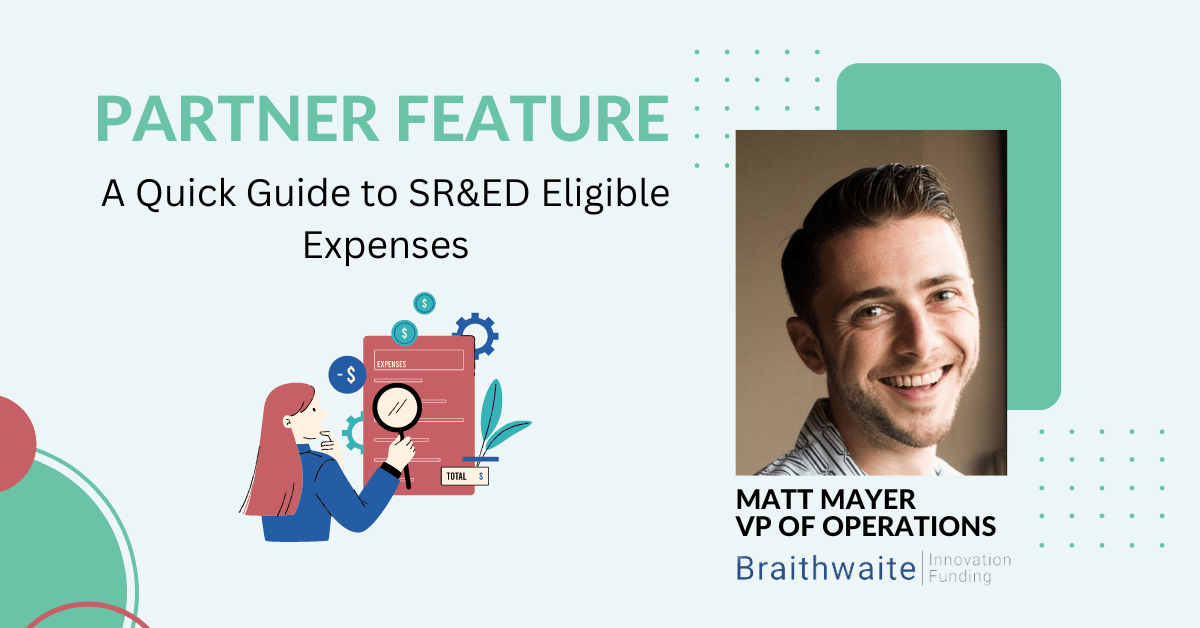Choosing the right SR&ED (Scientific Research & Experimental Development) consultant, getting the best price, getting the best service and having a successful relationship are keys to a successful claim. This guide will explain the areas to look for, questions to ask, and ways to evaluate a good fit. It will also walk you through what to expect from your SR&ED consultant, who will become one of your success partners.
What do SR&ED consultants do?
A SR&ED consultant is an individual or firm that assists a Canadian taxpayer in filing the SR&ED Schedule (Form T661) on your corporate tax return. There are often two components of SR&ED consulting. The first is a technical person who is highly skilled at answering the questions asked on the T661 and can explain why your R&D is SR&ED-eligible. The second is a financial person who is an expert at determining the size of your claim, how it fits with other government incentives, and how it interacts with other components of the tax return.
The Canadian Revenue Agency has a number of corporate tax incentive programs, with SR&ED being one of the largest. Receiving other tax incentives can affect your SR&ED claim, and so you need a skilled consultant who would advise you on how to best coordinate them.
Should you even use a SR&ED consultant?
Almost ¾ of corporate taxpayers use a SR&ED consultant. That’s because you are much more likely to achieve the results you are looking for by using a SR&ED consultant rather than trying to figure it all out for yourself. Like most professions, you probably know enough to do the basics. You don’t need a doctor to put on a band-aid or an engineer to build a dog house. However, if you have anything serious, can have a significant effect on your well-being, finances, or family, you’ll want to engage the best specialist for the job.
Not only do SR&ED consultants understand the tax laws, but they can also navigate the CRA and shepherd your claim through the system. By choosing the correct words to use, and specifically avoiding others in your claim, they can develop a strong SR&ED submission. Changes are made to the SR&ED program almost every year, and consultants keep up with these changes and how they can affect you. But most importantly, a consultant will advise you on what does and does not qualify for SR&ED based on what they have seen and increase your compliance with the CRA. What you think is a no-brainer may not qualify, and there may be qualifying components, either financial or technical, that you are missing out on if you’re filing your SR&ED claim yourself.
About one in five claims are selected for review by the CRA. Most companies choose to have a consultant navigate the review process and defend their claim while focusing on their customers and employees. In addition, there are ways to position the projects so that it is clear to the CRA what the technical uncertainties are and what you did to resolve them that could not be done via routine engineering.
The time we see companies not engaging a consultant is in the rare circumstance where the head of engineering/development is an expert at preparing SR&ED technical writeup, and the head of finance is an expert in what to include ineligible costs.
Overall, if you’re looking to increase the probability of filing a successful claim and rely on getting the refund with the least amount of hassle, hiring a consultant is your best strategy.
How to hire the right SR&ED consultant
Areas of specialization
The world of research can be divided into software, manufacturing, and biopharma.
The software bucket contains everything from firmware development to AI and SaaS, as well as anything in which coding is required. It is typically sufficient to have a good software consultant who understands full-stack development to be able to write any software-related SR&ED claim.
Manufacturing is everything where a tangible product is produced. It can be a silicon cell, a car, a microprocessor, bread, lumber, or adhesive. Manufacturing can be a bit trickier when it comes to filing. For instance, a claim from a bread-manufacturing company that may include chemistry-related items is very different from the claim of a forestry company. It is best to ask the consultant how many claims in the past 2 years they have completed with similar companies. If you feel that they understand the challenges and technology that you have then it will most likely be a good fit.
Anything medical or related to health-science goes under the biopharma category. Health science is typically specialized because of the way this industry conducts its experiments. For example, at the time of writing, a vaccine for COVID-19 does not exist. The research that is undertaken to find a vaccine is well documented and multiple experiments take place. This is quite different from software development where the technical challenge may not have a well-documented hypothesis and the detailed tracking found in laboratories.
Geographic considerations
Many years ago SR&ED consulting was done in person. A consultant would visit the client, bring with a tape recorder, and interview people to gather sufficient information to write a claim. Today it is more common for interviews to take place remotely, correspondence over email and API’s which connect to your systems to help provide contemporaneous documentation.
Overall it is more important to have a consultant that is skilled, knows your industry, and works effectively with your company than to have a person that you can meet face to face. Therefore, if you find there is an expert in automotive manufacturing located in Windsor and you have a manufacturing plant in Vancouver, work with the expert remotely rather than someone locally who is not as familiar with the nuances of automotive engineering.
Interviewing a potential consultant
You will develop a close relationship with your SR&ED consultant as you work with them throughout the year on your claim process. It’s important to take the time to ask the right questions and evaluate each option accordingly.
Use this handy questionnaire to interview consultants. The weighting is a suggestion that you can modify to suit your specific needs. Rank each consultant from 1 to 5. Multiply the weight by the score for each consultant, add up the scores and you will find your preferred consultant. You can make a copy of the Google Sheet here or download an Excel version here by clicking File then Download.
How much should you pay your SR&ED consultant?
The fee you end up paying your consultant depends on two factors, the size of your claim, and the type of consulting engagement you agree on. There are many flavours of consulting engagements. The most common ones are contingency, fixed fee, and time & materials. Don’t hesitate to contact any reputable firm to see what they can offer.
Contingency
Most SR&ED consultants work on a contingency fee. This means that they charge a percentage of the SR&ED credits (refundable and non-refundable) that you receive. Theoretically, this aligns the interest of the company with the consulting firm as the more credits you receive the happier everyone is. In addition, the consulting firm has an incentive not to be too aggressive as to trigger a review which would take more time but no more compensation.
Most consulting firms have a minimum charge of $10,000. Therefore, if you have a small claim, it may be more cost-effective to find an individual practitioner.
There are a number of different contingency models. The most popular are
- Single contingency, for example, 20% of the ITC’s approved
- Tiered Contingency, for example, 20% of the first $100,000 of ITC’s and 15% of the remainder.
There are many other variants including pricing caps, additional amounts for claims being selected for review, or fixed fee plus contingency.
Fixed-Fee
A fixed fee engagement is more often utilized for very large SR&ED claims. There are cases where other taxes and accounting services are being provided to the client which prevents the accountant from charging a contingency rate. The benefit of a fixed fee is that how much you will be paying for the SR&ED consulting services is clear. However, compared to contingency, there is a lack of alignment between the client and the service provider. It is similar to paying a business development person a base salary compared to a skilled consultant commission. Some sales models lend themselves to a lower base salary and significant upside from commissions while others minimize the commission component of the total compensation. Either way, there’s a tradeoff that you need to think about.
Oftentimes, with fixed-fee engagements, a SR&ED review is not included in the base pricing and the client will pay time & materials for defending the claim. Considering that the CRA will review the SR&ED on average once every 5 years, and the cost of this can be expensive, it is not clear if a fixed fee is more or less expensive than contingency.
Project-Based
For larger companies, a project-based engagement may be a cost-effective answer to engaging a SR&ED consultant as it provides an incentive for the consultant to seek out new projects. As companies grow, more projects may be identified. Because the T661 form requires documentation for each project, the amount of effort expended by the consultant is typically directly related to the size and number of projects.
Similar to the fixed-fee model, most often CRA review support is not included in the per-project price. So be ready to pay extra if you’re selected for a review.
Time & Materials
In specific circumstances, a client will pay an hourly rate for the input of a SR&ED consultant. We see this most often when a company prepares its own claim and would like a professional to review and check the submission. A SR&ED claim is rarelycancelled prepared from scratch based on an hourly rate.
How the CRA works with consultants
There are many reasons why using a consultant makes sense for your business, but does the CRA want you to use one?
Firstly, all taxpayers are entitled to representation. Therefore, you are always allowed to have a consultant prepare your tax that is submitted on your behalf to the CRA. Remember that the buck stops with you so no matter what the consultant writes or does, the taxpayer is ultimately responsible when they sign off.
A few years ago, the CRA put in place the First Time Claimant Advisory Service (FTCAS). This is an opportunity for the CRA to force the taxpayer to meet with a Research and Technical Advisor (RTA) and a Financial Reviewer (FR). If this is your first SR&ED claim in more than three years, you are either selected for a full review or FTCAS. Being selected for an FTCAS means your claim is accepted as filed, but you won’t get the SR&ED refund until you have met with the RTA & FR. In the FTCAS meeting, the CRA will introduce and review the SR&ED program, provide guidance on effective ways to claim SR&ED, and may provide comments relating to the claim you submitted.
The meeting is usually less than two hours long. For companies that are not familiar with the SR&ED program, it can be very informative and helpful. The more you are familiar with the program from prior companies, the less valuable the meeting will be. The CRA introduced this program to educate taxpayers, demystify the SR&ED program, and provide guidance on what is considered SR&ED eligible activities. In part, this was an effort to reduce the number of claims that did not qualify for the program and have greater certainty for the taxpayer when they submitted a claim. Oftentimes, the consultant is not present as there is no input that they can provide and the CRA is focused on the employees of the company.
One big question is does the CRA discriminate between consultants. Some consultants might repeatedly push the boundaries with their claims and therefore a disproportionate number of them would be selected for review leading to less than the average results. However, we believe that the CRA is objective with every claim and adjudicates each claim based on its merits. However, the people reviewing the claim have come to expect certain thresholds from consultants. The CRA knows that certain consultants understand the details of the SR&ED program very well and their claims reflect it. The CRA is also aware that certain consultants will try to claim as much as possible in the slim chance the CRA will accept it.
When the CRA meets with the company for a review, they like to talk to the people at the company rather than the consultant. In general, the CRA does not want the consultant to be the lead for the company but would like the technical and financial people at the company to answer their questions with the support of the consultant.
Each CRA reviewer is unique as is each consultant. The chemistry, respect, and understanding of the way each person works all have an important role for those claims that may or may not be eligible.
CRA Reviews and Objections
While most claims are approved as filed, some are selected for review. There are multiple stages that the claim can go through:
- Claim submitted to CRA on form T661
- CRA screening based on an algorithm to determine if the claim should be selected for review
- If the claim fails the screening, it is passed to an RTA & FR. They may review the claim and either accept it as filed, ask questions about specific technical or financial areas, or select the claim for a full financial and technical review.
- If the claim is selected for a full review, the review team can accept the claim as filed, adjust the claim to less than was filed, or completely reject the claim.
- If the taxpayer is dissatisfied with the assessment of the reviewers, they can appeal to the reviewer’s manager.
- If the manager concurs with the reviewers, the taxpayer can object to the assessment, in which case the claim is reviewed (without interaction with the taxpayer) by a team in Ottawa.
- If the objection is denied, the taxpayer can submit the claim to the Tax Court of Canada for adjudication. For small claims, there is a fast procedure where a judge will rule on the evidence presented by the taxpayer, an expert witness, and the CRA. There is no need to have legal representation. This is called the informal procedure, and the maximum award is $25,0000. For larger claims, a full tax court proceeding is undertaken.
- The tax court judgment can be appealed, although this is exceedingly rare.
While the CRA gets it right the vast majority of the time, there are circumstances where the CRA misses the mark for a variety of reasons. The CRA’s guide for their staff, the SR&ED Claim Review Manual, closely (but not perfectly) aligns with the tax law. Therefore, if you’re going to challenge the CRA, you should be certain you’re on firm footing and have a great consultant and/or tax lawyer on your side. Unfortunately, over the past decade, the number of claims in front of the tax court of Canada has increased substantially. Most of these are large claims with very specific reasons why the taxpayer feels the CRA erred in their assessment.
Review the consulting agreement/engagement
Of all the different aspects you’ll be looking at when selecting a consultant, this is one of the most worthy of your attention. Some agreements are evergreen and continue in perpetuity unless cancelled, while other agreements are for a fixed term, typically 2 to 3 years. There are also annual contracts that can be changed every year. Some agreements provide you with a lot of flexibility, while in others, the consultant can engage lawyers to force you to file a claim.
Evergreen contracts are often optimal as the pricing is predictable, and if you’re happy with the service you’re receiving then you will continue, if not, cancelling is simple. Signing up for a multi-year contract is advisable if you can agree on a lower fee and you trust the consulting firm. Keep in mind that in some firms, the salesperson has nothing to do with providing consulting services, while in others, the salesperson is the consultant.
The contract should be simple. If it is more than three pages, there is something amiss. Large accounting firms often have legalese which is not specific to the consulting engagement. Smaller consulting firms have concise contracts. Overall, be careful who has the “power” in the agreement. If you feel that the claim is questionable, must you submit it? If the CRA rejected your claim in the prior year, are you obligated to file a claim this year if the consultant feels it is appropriate? There are many questions that may arise out of the wording of the contract, so read it very carefully!
Final Thoughts
Selecting a SR&ED consultant is one of the most important financial decisions a company can make. A great partnership will result in successful claims year after year. Remember that the SR&ED program provides over $3B to Canadian companies, so you want to work with a consultant that has the greatest probability of getting you your fair share. Think about what attributes are important to you, so the consultant has the greatest value to your company. If it is automation or gathering contemporaneous documentation or a consultant who has filed many similar claims or a specific pricing structure, ensure you consider all variables closely. Fortunately, there are many exceptional consulting and accounting firms and hundreds of SR&ED experts that can help you.
Now that you know everything you need about hiring a SR&ED consultant, you can use our comprehensive directory to find the right one for your business.




